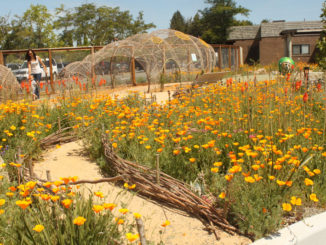Recently, I reviewed Overgrown by Julian Raxworthy, in which he calls on landscape architects to create a new form of practice that learns from gardening and “optimizes the exciting properties of plants through changing the way landscape architects work” which he is calling “the viridic”. Raxworthy provides a series of positions “for reformulation of landscape-architectural practice that combines the landscape architect and gardener” including:
- breaking the split between human and plant
- recognising that the nature of a plant is to grow and that the result of the design happens after planting over seasons, years, and decades.
- landscape design should learn from maintenance techniques of gardening and tailor plans to suit.
- the role of the garden is a learning environment and testing ground.
- the nature of “the viridic” is iterative.
- leaving the office and our plans & simulations to learn from gardening and gardeners.
Through reading Overgrown and Cleveland’s Landscape Architecture I began to consider whether a new form of practice can be achieved? Can we move beyond our prejudices to embrace and learn from gardening? Can we design without falling back onto plans and specifications or can they be reformulated into a more flexible documents to achieve the design through site design?
There are numerous examples of garden designers and landscape architects such as Olmsted, Guilfoyle, Repton, Mueller, Brown, worked with plans and gardeners in the field to create, sculpt, position, and evolve their designs. Of course, we as contemporary landscape architects cannot spend hours, days, weeks, on site to achieve the design outcome we desire; however, we can use some of the ideas and methods to enhance our design process from concept to ongoing maintenance.
In my experience in the past, I have worked in practices which utilised a more reiterative approach to design landscapes. Key to this approach was working in the field during construction and after the design was built. Often there would be plans with large areas hatched indicating to the contractor that design was indicative, and the final design will be set-out, sculpted and created on-site. We also visited sites periodically after the construction was finished and site open to further reiterate the design (including replacing or adding plant species), until the design practice and client were happy with the final outcome. We would learn from these projects and use those learnings when designing new projects. This approach could not be defined as pure “viridic” practice but had many of the elements which Raxworthy seeks for landscape architects to adopt.
Of course, this approach couldn’t be used on every project due to clients unwilling to pay fees for this extensive service and other clients who weren’t amenable to more reiterative, free design approach. It was only through collaboration with clients and contractors and managing expectations that we were able to achieve these great outcomes. Also, the contemporary landscape architectural profession in China is still young with designers and clients willing to try out new ways of designing and building.
There are many reasons why the “viridic” formation of practice would be challenging to achieve is due to various ingrained practices in landscape architecture. We often are cornered by clients, other professions and contractors to provide fully documented and resolved plans, and specifications. This is due to clients and contractors managing risk and are often unwilling to pay for inspections beyond the construction completion and the maintenance hand over (12-24 months later).
As Raxworthy stated there is a division between landscape architects and gardeners, we shun gardening and we are too proud and afraid to realise that our designs are not static and that they grow, change, die and regenerate over time. We seek to control the landscape through design and create our final vision when the final documents are merely the starting point and we need to embrace the nature of plants.
There are ways that we can create the “viridic” approach into practice (without extra fees) by gaining a better understanding of plant growth, maintenance practices and integrate these learnings into the design process. We can seek to collaborate or employ horticulturalists and gardeners within our practices to provide advice. More importantly, we can learn from our own designs by undertaking site inspections over regular intervals and having conversations with the local community, maintenance teams to learn what fails and works to integrate into our design process. Most of all we need to educate clients (and the public) that unlike buildings, landscapes are living, growing, and require design input throughout the construction and maintenance process to achieve the best outcome.

Article Written by Damian Holmes is the Founder and Editor of WLA.
He is also a registered Landscape Architect with extensive experience in Australia, Canada, and China.



